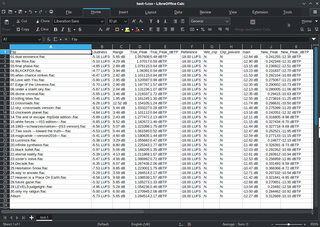 SuperCalc 5.1 for MS-DOS. | |
| Developer(s) | Sorcim |
|---|---|
| Initial release | 1980 |
| Stable release | 5.5 |
| Operating system | CP/M; MS-DOS; VMS |
| Type | Spreadsheet |
SuperCalc is a CP/M-80 spreadsheet application published by Sorcim in 1980.
 SuperCalc 5.1 for MS-DOS. | |
| Developer(s) | Sorcim |
|---|---|
| Initial release | 1980 |
| Stable release | 5.5 |
| Operating system | CP/M; MS-DOS; VMS |
| Type | Spreadsheet |
SuperCalc is a CP/M-80 spreadsheet application published by Sorcim in 1980.
VisiCalc was the first spreadsheet program but its release for the CP/M operating system ran only on the HP-125, Sharp MZ80, and the Sony SMC-70. SuperCalc was created to fill that void and market opportunity. Alongside WordStar, it was one of the CP/M applications bundled with the Osborne 1 portable computer. It quickly became popular[ citation needed ] and was ported to MS-DOS in 1982.
An improvement over VisiCalc (though using much the same command structure using the slash key), SuperCalc was one of the first spreadsheet programs capable of iteratively solving circular references (cells that depend on each other's results). It would be over 10 years after the introduction of SuperCalc before this feature was implemented in Microsoft Excel, although in Lotus 1-2-3, manual programming of iterative logic could also be used to solve this issue. According to the SuperCalc product manager, iterative calculations were added when Sorcim changed from binary-coded decimal to binary math. Since the precision of the two math packages was different, some IF statements resolved differently, and iterative calculations helped solve this problem. [1]
Versions of SuperCalc were later released for the Apple II, for PCs running MS-DOS, and, after Sorcim was bought by CA Technologies (CA) in 1985, for Microsoft Windows (under the name CA-SuperCalc). SuperCalc was CA Technologies' first personal computer product. [2] The MS-DOS versions were more popular with many users than the market-leading Lotus 1-2-3, because it was distributed without copy protection, [3] as well as being priced lower.
By the release of version 3 in March 1987, a million users were claimed. [4] New versions were published into the early 1990s, after which Microsoft Excel dominated the spreadsheet market.
In 1993, the Ministry of Railway of Russia signed an agreement with CA Technologies after a Russian employee illegally used SuperCalc for government purposes. [5]

Robert M. Frankston is an American software engineer and businessman who co-created, with Dan Bricklin, the VisiCalc spreadsheet program. Frankston is also the co-founder of Software Arts.

Lotus 1-2-3 is a discontinued spreadsheet program from Lotus Software. It was the first killer application of the IBM PC, was hugely popular in the 1980s, and significantly contributed to the success of IBM PC-compatibles in the business market.

Microsoft Excel is a spreadsheet editor developed by Microsoft for Windows, macOS, Android, iOS and iPadOS. It features calculation or computation capabilities, graphing tools, pivot tables, and a macro programming language called Visual Basic for Applications (VBA). Excel forms part of the Microsoft 365 suite of software.

Multiplan is spreadsheet program developed by Microsoft and introduced in 1982 as a competitor to VisiCalc.

A spreadsheet is a computer application for computation, organization, analysis and storage of data in tabular form. Spreadsheets were developed as computerized analogs of paper accounting worksheets. The program operates on data entered in cells of a table. Each cell may contain either numeric or text data, or the results of formulas that automatically calculate and display a value based on the contents of other cells. The term spreadsheet may also refer to one such electronic document.

VisiCalc is the first spreadsheet computer program for personal computers, originally released for Apple II by VisiCorp on October 17, 1979. It is considered the killer application for the Apple II, turning the microcomputer from a hobby for computer enthusiasts into a serious business tool, and then prompting IBM to introduce the IBM PC two years later. More than 700,000 copies were sold in six years, and up to 1 million copies over its history.

Lotus Improv is a discontinued spreadsheet program from Lotus Development released in 1991 for the NeXTSTEP platform and then for Windows 3.1 in 1993. Development was put on hiatus in 1994 after slow sales on the Windows platform, and officially ended in April 1996 after Lotus was purchased by IBM.
A killer application is any software that is so necessary or desirable that it proves the core value of some larger technology, such as its host computer hardware, video game console, software platform, or operating system. Consumers would buy the host platform just to access that application, possibly substantially increasing sales of its host platform.
Lotus Software was an American software company based in Massachusetts; it was "offloaded" to India's HCL Technologies in 2018.
Quattro Pro is a spreadsheet program developed by Borland and now sold by Corel, most often as part of Corel's WordPerfect Office suite.

The Amstrad PC1512 was Amstrad's mostly IBM PC-compatible computer system, first manufactured in 1986. Next year a slight updated version named PC1640 was introduced. It was also marketed as PC6400, and Sinclair PC500. Schneider branded machines for the german marked also exist.

VisiCorp Visi On was a short-lived but influential graphical user interface-based operating environment program for IBM compatible personal computers running MS-DOS. Although Visi On was never popular, as it had steep minimum system requirements for its day, it was a major influence on the later development of Microsoft Windows.

VisiCorp was an early personal computer software publisher. Its most famous products were Microchess, Visi On and VisiCalc.
TK Solver is a mathematical modeling and problem solving software system based on a declarative, rule-based language, commercialized by Universal Technical Systems, Inc.

Javelin Software Corporation (1984–1988) was a company in Cambridge, Massachusetts, USA, which developed an innovative modeling and data analysis product, also called Javelin, and later Javelin Plus. Seen as the successor technology to spreadsheet software in reviews of the time, and rival to the then-dominant Lotus 1-2-3, Javelin won numerous industry awards, including beating Microsoft's new Excel for the InfoWorld Software Product of the Year award.
Data Interchange Format (.dif) is a text file format used to import/export single spreadsheets between spreadsheet programs.
This article presents a timeline of events in the history of 16-bit x86 DOS-family disk operating systems from 1980 to present. Non-x86 operating systems named "DOS" are not part of the scope of this timeline.
Sorcim Corporation was an early start-up company in Silicon Valley, founded in June 1980 by Richard Frank, Paul McQuesten, Martin Herbach, Anil Lakhwara, and Steve Jasik - all former Control Data Corporation employees working in the Language Group in Sunnyvale, CA. Jasik left company early on, to develop the MacNosy product for the Macintosh.
Lifeboat Associates was a New York City company that was one of the largest microcomputer software distributors in the late 1970s and early 1980s. Lifeboat acted as an independent software broker marketing software to major hardware vendors such as Xerox, HP and Altos. As such Lifeboat Associates was instrumental in the founding of Autodesk and also financed the creation of PC Magazine.